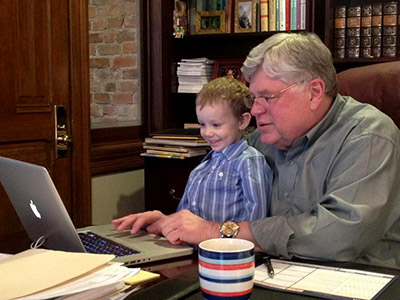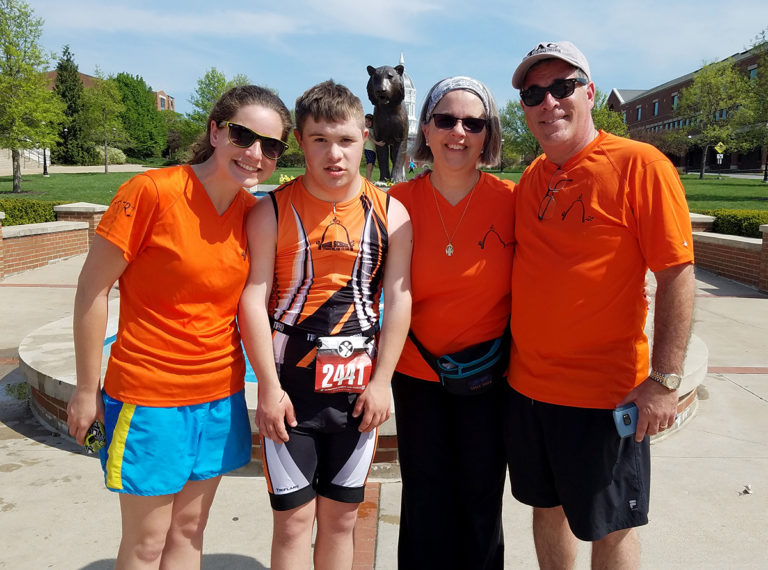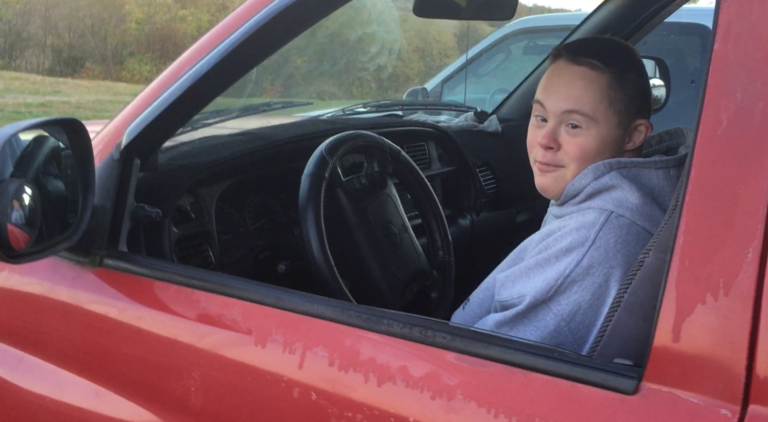Beyond “Therapy”
Thoughts on factors influencing gross and fine motor development, with ramifications affecting cognitive function and language in developmentally challenged children.
by Bob Doman
 I have observed a number of problems in our children whose overall development is slower than that of typically developing children, issues that are only indirectly associated with the actual neurological and physical aspects of their function.
I have observed a number of problems in our children whose overall development is slower than that of typically developing children, issues that are only indirectly associated with the actual neurological and physical aspects of their function.
The degree to which the brain seeks change is related to the rate of development.
For most children with developmental issues the sequence and steps of fine and gross motor development are as those of neuro-typical children, albeit often slower and impacted by structural issues. The slower developing area of function unfortunately creates some extra hurdles for our families and children.
In a typically developing child things happen fast. From birth to 3 years, every time you blink the child has started to do something new. During this time they go from being totally dependent and lacking mobility, hand use, or communication, to being able to run and jump, carry out most self-help functions, and speaking in sentences. Often in the period between just six and twelve months, the child learns to crawl on their belly, then pops up onto their hands and knees and creeps, and then are pulling to stand, cruising, and taking their first steps, all seemingly in the blink of an eye and without any specific help or intervention. Their brain is driven to do new things. Change stimulates change. Change is their norm. Slow down the rate of development of motor function or cognition, and homeostasis becomes the norm. The brain appears to learn to be happy maintaining the status quo, staying right where it is and not rocking the boat.
This tendency to stay put, stay in the same place, and not push forward often appears directly related to the rate of change. The slower the development, the less likely the child is to try new things and often to even perceive that they can or could do new things. The longer the child stays at a level, the less likely the child is going to initiate movement to the next level, all of which necessitates not only putting the neurodevelopmental and structural issues in place, but pushing, pulling, and trying to motivate the child to the next level. We can actually use Newton’s First Law of Motion to help understand what is happening.
An object at rest tends to stay at rest unless an external force acts upon it, and an object in motion will tend to maintain its velocity unless an external force is applied to it as well.
I believe we can use Newton’s law to help understand global development, as well as specific function. The slower the overall development, the slower the overall development tends to be without external force; and for specific functions, the longer the child goes without doing something, the more external force is required to get the child to that next step. I believe this is true whether we are trying to get a child to crawl or walk, communicate or speak, initiate self feeding or use a spoon, or process and think. For example, the longer a child goes without doing things for themselves, the harder it is and the more input required for them to even know that they can initiate the function, let alone starting to actually try and do it themselves and then incorporating it into their daily lives.
The slower the child’s development, the more external force, specific input (program) and encouragement/external force is required to get the child moving. Once moving, they will tend to maintain and not increase their rate of development unless we continually provide more input and external force.
Parents and others involved with children with delayed development need to be very mindful that contrary to a child developing at a typical rate, that their child is very possibly not going to just take the next step themselves, but will need constant pushing and encouragement to take that next step. It is often the mindset of those involved in the child’s development that if we put the pieces together, the child will be self-motivated to take advantage of the new abilities and use it to their advantage. Given that the innate personalities of children vary tremendously and that the internal drive varies from child to child, it does appear that the degree to which the child pushes themselves to the next level is directly related to their rate of change in a specific developmental area. If the global development is impacted, the global rate of development can be seen as proportional to the existing rate and is in need of global push. If specific areas are involved, those specific areas will need the extra focus and push. For example, a child with cerebral palsy who has significantly more physical issues than cognitive issues will perhaps only need to be provided with the opportunity to develop cognitively and academically; but regarding their physical development, they will need not only a lot of input, but will need extra push, motivation, and external force to achieve the motor function. Some of the more frustrating aspects of this problem revolve around those whose processing has been slow to develop. Aspects of function that can be linked to processing, such as complexity of thought or language, will often not just naturally fall in place. As with the motor function where the pieces are in place but the child does not seem motivated to take that step, or when we are dealing with improved processing, we often need to provide the external stimuli or force and teach the child to actually use their new processing skills. As an example, you are not going to see real development in conversational language unless you have lots of conversations with the child and push them to say more, regardless of how well the associated pieces are put together.
A child will not further develop or generalize a function unless they use it.
The slower the development, the slower the child’s brain is to move from homeostasis and go forward. But having moved a bit forward, it is in using the function that it really advances and becomes integrated.
We at NACD encourage parents to push their children to do chores and develop self-help skills. As I have told so many families, anything your child can do, they should do.If your child can feed themselves, they should feed themselves. That’s how they get better at it. If your child can take off their socks, then they should take off their socks. That’s how they get better at it. If your child can do double-digit addition, then they should do it without prompts. That’s how they get better at it. And, not only better at that immediate specific function or skill, but at the ones to follow as well.
Parents often get stuck with the wrong perception of “therapy.” Therapy is seen as the begin all and end all. “‘Therapy’ is what is going to get my child to learn how to use his hands together, and when ‘therapy’ has done its job, then my child’s hand function will be ‘normal.’” Not so. Therapy, or therapeutic aspects of program, is what is done to help address specific issues. For example, if a child has low tone and poor strength in their hands, we will do neurodevelopmental therapy (program) to help build the tone, to build the strength and then the grasp and release, finger isolation, finger opposition, etc. But it is the child’s using their hands that really develop the hands. This piece goes back to the preceding piece. If a developmentally delayed child hasn’t been doing something such as spoon-feeding themselves, they often are not going to do this until they are really encouraged to do it; and once they can do it, they really need to do it. It is the actual application of the neurodevelopmental function, combining all of the various pieces, that really pushes the overall development and generalizes the function. Generalizing implies that the child is going to learn from use and encouragement to do new related self-help and play skills that involve the associated neurodevelopmental abilities, and that this use is what really integrates and establishes the functionality. Many chores and self-help activities involve use and integration of many specific functions. The utilization of and integration of these various aspects of the function is critical to the overall progression. For example, if we push a child to do a chore such as matching socks and putting the socks together, even though it is initially quite difficult for them, this task integrates many different important functions that are going to foster the development of many other functional activities.
To many parents, giving a developmentally challenged child a pile of socks to sort, match, and put together may be perceived as an impossible or a Herculean task, and so it might be. But we teach the child to match two socks, then two pairs of socks, and then three pairs. Then we teach a child how to take two matched socks and put the two socks together. The process of doing this is teaching the child to pay attention, to build their attention span and focus. We are also building their central macular vision and teaching them to tune out what is happening peripherally. We are helping them to learn how to converge their eyes, thus building their depth perception. They are manipulating the socks, trying to see if they match, then putting them together, grasping, releasing, isolating fingers, using fingers in opposition, supinating their wrists, strengthening their hands. And they are learning to do a chore and, possibly for the first time in their lives, actually doing something that helps the family, and learning that the universe doesn’t entirely revolve around them. The sock chore is going to help them with washing the dishes, doing the laundry, vacuuming the rug, catching and throwing a ball, scribbling, coloring, writing. This is the real program. This is what really drives the development.
Therapy is defined as a treatment for an illness or a disability. Traditionally a parent took their child to therapy a couple of times per week for a treatment, as if getting a shot of medication twice a week; but that hasn’t really worked for developmental issues, and it isn’t really going to work; nor is merely checking off boxes of a home-based program. A more holistic perspective is needed.
Having used the term “neurodevelopmental” since back in the early ‘70s, I define an “NACD Neurodevelopmental Program” as follows: A dynamic comprehensive combination of specific techniques and methodologies which are provided within the context of life and the home, delivered daily with sufficient frequency, intensity, and duration, provided by parents and caregivers who are working with the whole child and who are mindful of integrating and incorporating the specific priorities and goals and who are preferably impatient for results. Even as such it is important for parents to remain mindful that we are working to improve function, not to check off boxes. Priority needs to be placed on getting the child to use the pieces that we put together and to provide the necessary opportunity, motivation, and push to move them forward.The more difficult and slower the area of development, the more it needs to be defined, emphasized, prioritized, and incorporated into the child’s life.
In the gestalt of a developmentally challenged child, those areas with the slowest movement are those that generally need the greatest focus and push, with special emphasis placed upon utilization and integration of that function into daily life.





